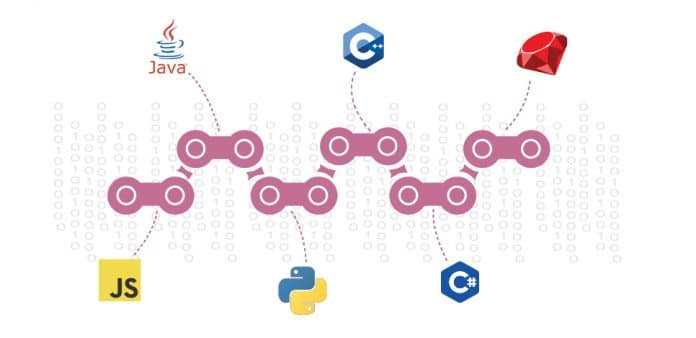Blockchain has laid the foundations for a new kind of Internet by allowing information to be distributed and not copied. Originally devised for digital cryptocurrencies, it is now finding uses in different spheres, with new vistas opening up every other day. Listed in this article are the open-source programming languages that blockchain is powered by.
Blockchain technology has the power to disrupt every industry and transform it. It has taken the world by storm and is experiencing a boom currently. Almost anyone you meet from the tech landscape knows about blockchain and its mind-blowing advantages.
Why only blockchain?
Blockchain is basically a decentralised distributed ledger that allows for the permanent and stable storage of data over a large peer-to-peer network without the need for a centralised entity. Security and transparency are the two main features and advantages of any blockchain.
Every scrap of information received on the blockchain network will be visible to all other participants. Tampering with information specifically is practically impossible. This is because of its immutable nature.
The blocks in a blockchain are linked using cryptography, which refers to the techniques used for secure communication within a blockchain network in a subtle way. Hence, a blockchain is highly protected and secure, which is a significant plus point.
Here is a list of languages that are used to build blockchain applications.
Java programming language
Primarily used for Web designing, Java is a general-purpose programming language that is object-oriented, concurrent and class based. It was introduced in 1995 and currently ranks among the top three programming languages in the world.
There are, at present, more than nine to ten million Java developers worldwide, which is definitely a large number. The language helps to link blocks of information easily. Java simplifies the establishment of links between the data and sends it back to the user. It can run on any of the computer formats with a simple installation of the well-known Java Runtime Environment (JRE). It is very useful in building plain and immutable blockchain applications. Immutability makes it impossible for the public to alter the contents in a block after it has been verified.
Every new block included in a blockchain also includes the hash (link) of the previous block along with a unique hash (link) for the new block.
JavaScript (JS)
Usually abbreviated as JS, JavaScript is a multi-paradigm language that is functional, event-driven and also includes object-oriented and prototype-based programming styles. It is one of the most famous programming languages in the world used by at least 9.7 million developers.
C++
Here’s a sample block class code, just to give you an idea:
class Block {
public:
string sPrevHash;
Block(uint32_t nIndexIn, const string &sDataIn);
string GetHash();
void MineBlock(uint32_t nDifficulty);
private:
uint32_t _nIndex;
int64_t _nNonce;
string _sData;
string _sHash;
time_t _tTime;
string _CalculateHash() const;
};
C++ was earlier developed as an extension to the all-rounder C programming language. The object-oriented C++ was built on process-oriented C.
This blockchain programming language provides for the efficient administration of resources and offers greater command over memory. A blockchain requires many users and miners to connect and operate, both systematically and together.
C++ creates applications that can not only coordinate between numerous endpoints but can also deal with their interactions very quickly. That’s why blockchain projects like Bitcoin, Ethereum and Ripple are all built in C++.
C#
Just like C++, this is also an object-oriented programming language that enables developers to build robust programs. It has more than two million developers around the globe. C# was developed in the late 2000s. Since then, it has grown into a famous programming language that is used to build cross-platform code and programs that work in multiple operating systems such as Windows, Linux, Mac and Android.
Python
Python is an excellent language for programming and Web development, popular with developers and data experts. It is now a top blockchain programming language too.
Created by a Dutch programmer to be a straightforward and a minimalistic programming language, it includes many frameworks that help achieve outstanding Web programming flexibility. Python eliminates the need to write bulky code. Its built-in test environment helps to install a problem location in the short term. It thus quickly builds blocks with suitable information and combines these with each other.
Python has a large and active community that has released many libraries such as SciPy, NumPy and Pandas for a range of technical operations in math, science and engineering.
Specifically, Python is good at crunching data—taking large data collections and cleaning, processing, testing and visualising them. These techniques lend themselves very well to data-driven industries such as the Internet of Things.
Ruby
This programming language lets you run object-oriented programming without any difficulties. It is a very versatile language that enables the programmer to work on a mix of languages to make the required blockchain program, which cannot be easily hacked by users or even by professional hackers.
Ruby is recognised across the globe and can be used for free to create blockchain programs. It also allows a programmer to customise programs quickly. It has now built up momentum as a blockchain programming language. It also helps blockchain developers to prototype their ideas rapidly using open source, third party plugins and APIs.
Blockchain is an extremely engaging and interesting technology that will be with us for the long term.
Many people are now learning programming languages owing to their high levels of security. If you are creating an application with blockchain technology, you need to learn how to code. These languages don’t just help in creating applications for the blockchain but also help in developing blockchain contract-based languages.



















































































